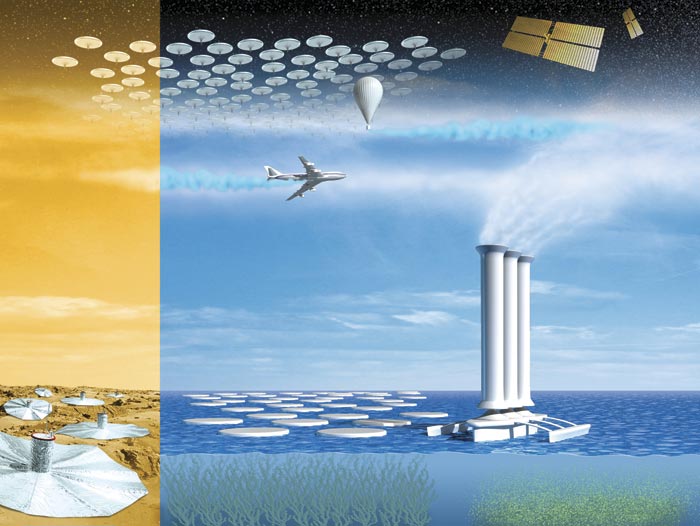by Craig Collins
“Out of the frying pan, into the fire” is an apt description of our current place in history. No matter what you think of globalization, I believe we’ll soon discover that capitalism without it is much, much worse.
No one needs to convince establishment economists, politicians and pundits that the absence of globalization and growth spells trouble. They’ve pushed globalization as the Viagra of economic growth for years. But globalization has never been popular with everyone. Capitalism’s critics recognize that it generates tremendous wealth and power for a tiny fraction of the Earth’s seven billion people, makes room for some in the middle class, but keeps most of humanity destitute and desperate, while trashing the planet and jeopardizing human survival for generations to come.
Around the world, social movements voice their opposition to voracious growth and unite around the belief that “Another World Is Possible!” They work toward the day when neoliberal globalization is replaced by a more democratic, equitable, Earth-friendly society. They assume that any future without globalization is bound to be an improvement. But it appears that this assumption may be wrong. In fact, future generations may someday look back on capitalism’s growth phase as the vigorous days of industrial civilization, a naïve time before anyone realized that the worst was yet to come.
Profit: the prime directive
Today, energy depletion, ecological disaster, debilitating debt, and economic inequity are suffocating globalization and growth. The Age of Fossil Fuels has reached its apex. The rapacious flight to the top was powered by the Earth’s dwindling hydrocarbon reserves. From these lofty heights, the drastic drop-off ahead appears perilous. As fossil fuel extraction fails to meet global demand, economic contraction and downward mobility will become the new normal and growth will fade into memory. But this new growth-less future may bear no resemblance to the equitable green economy activists have been calling for.
Optimistic green reformers like Al Gore, Jeremy Rifkin, and Lester Brown see a window of opportunity at this historic juncture. For years, they’ve jetted from one conference to another, tirelessly trying to convince world leaders to embrace their planet-saving plans for a sustainable, carbon-free society before it’s too late. They hope energy scarcity and economic contraction can act as wake-up calls, spurring world leaders to embrace their Green New Deals that promise to save capitalism and the planet.
Their message is clear: rapid, fossil-fueled growth is burning through the Earth’s remaining reserves of precious hydrocarbons and doing untold damage to the biosphere in the process. Businesses must lead the way out of this dangerous dead end by adopting renewable energy and other planet-healing practices, even if it means substantial reductions in growth and profits. But, despite their dire warnings, hard work, innovative proposals, and good intentions, most heads of state and captains of industry continue to politely ignore them.
Meanwhile, more radical activists also hope climate chaos, peak oil and economic contraction will become game changers. Many assume that globalization and growth are so essential that capitalism must fail without them. And, as it does, social movements will seize the opportunity to transform this collapsing system into a more equitable, sustainable one, free of capitalism’s insatiable need to expand at all costs.
Growth is not the primary driving force behind capitalism—profit is. Periods of crisis and collapse can generate huge profits as well.
Both the green growth reformers and anti-growth radicals misunderstand the true nature of capitalism and underestimate its ability to withstand—and profit handsomely from—the great contraction ahead. Growth is not the primary driving force behind capitalism—profit is. When the overall economic pie is expanding, many firms find it easier to realize profits big enough to continually increase their share price. But periods of crisis and collapse can generate huge profits as well. In fact, during systemic contractions, the dog-eat-dog nature of capitalism creates lucrative opportunities for hostile takeovers, mergers and leveraged buyouts, allowing the most predatory firms to devour their competition.
Can capitalism survive without growth?
One of capitalism’s central attributes is opportunism. Capitalism is not loyal to any person, nation, corporation, or ideology. It doesn’t care about the planet or believe in justice, equality, fairness, liberty, human rights, democracy, world peace or even economic growth and the “free market.” Its overriding obsession is maximizing the return on invested capital. Capitalism will pose as a loyal friend of other beliefs and values, or betray them in an instant, if it advances the drive for profit … that’s why it’s called the bottom line!
Growth is important because it tends to improve the bottom line. And ultimately, capitalism may not last without it. But those who profit from this economic system are not about to throw up their hands and walk off the stage of history just because boom has turned to bust. Crisis, conflict, and collapse can be extremely profitable for the opportunists who know where and when to invest.
But how long can this go on? Can capitalism’s profit motive remain the driving force behind a contracting economy lacking the vital energy surplus needed to fuel growth? Definitely, but the consequences for society will be grim indeed. Without access to the cheap, abundant energy needed to extract resources, power factories, maintain infrastructure, and transport goods around the world, capitalism’s productive sector will lose its position as the most lucrative source of profit and investment. Transnational corporations will find that their giant economies of scale and global chains of production have become liabilities rather than assets. As profits dwindle, factories close, workers are laid off, benefits and wages are slashed, unions are broken, and pension funds are raided—whatever it takes to remain solvent.
Declining incomes and living standards mean poorer consumers, contracting markets and shrinking tax revenues. Of course, collapse can be postponed by using debt to artificially extend the solvency of businesses, consumers, and governments. But eventually, paying off debts with interest becomes futile without growth. And, when the credit bubbles burst, the defaults, foreclosures, bankruptcies and financial fiascos that follow can paralyze the economy.
Without the capacity for re-energizing growth, the recessions and depressions of times past that temporarily disrupted production between long periods of expansion, now become chronic features of a contracting system. On the downside of peak oil, neither liberal programs to increase employment and stimulate growth nor conservative tax and regulatory cuts have any substantial impact on the economy’s descending spiral. Both production and demand remain so constricted by energy austerity that any brief growth spurts are quickly stifled by resurgent energy prices. Instead, periods of severe contraction and collapse may be buffered between brief plateaus of relative stability.
Catabolism: the final phase of capitalism
In a growth-less, contracting economy, the profit motive can have a powerful catabolic impact on capitalist society. The word “catabolism” comes from the Greek and is used in biology to refer to the condition whereby a living thing feeds on itself. Thus, catabolic capitalism is a self-cannibalizing system whose insatiable hunger for profit can only be fed by devouring the society that sustains it.[1] As it rampages down the road to ruin, this system gorges itself on one self-inflicted disaster after another.
The riotous train scene in the film The Marx Brothers Go West captures the essence of catabolic capitalism. The wacky brothers commandeer a locomotive that runs out of fuel. In desperation, they ransack the train, breaking up the passenger cars, ripping up seats and tearing down roofs and walls to feed the steam engine. By the end of the scene, terrified passengers desperately cling to a skeletal train, reduced to little more than a fast-moving furnace on wheels.
In the previous era of industrial expansion, catabolic capitalists lurked in the shadows of the growth economy. They were the illicit arms, drugs and sex traffickers; the loan sharks, debt collectors and repo-men; the smugglers, pirates, poachers, black market merchants and pawnbrokers; the illegal waste dumpers, shady sweatshop operators and unregulated mining, fishing and timber operations.
However, as the productive sector contracts, this corrupt cannibalistic sector emerges from the shadows and metastasizes rapidly, thriving off conflict, crime and crisis; hoarding and speculation; insecurity and desperation. Catabolic capitalism flourishes because it can still generate substantial profits by dodging legalities and regulations; stockpiling scarce resources and peddling arms to those fighting over them; scavenging, breaking down and selling off the assets of the decaying productive and public sectors; and preying upon the sheer desperation of people who can no longer find gainful employment elsewhere.
Scavengers, speculators, and slumlords buy up distressed and abandoned properties—houses, schools, factories, office buildings and malls—strip them of valuable resources, sell them for scrap or rent them to people desperate for shelter.
Without enough energy to generate growth, catabolic capitalists stoke the profit engine by taking over troubled businesses, selling them off for parts, firing the workforce and pilfering their pensions. Scavengers, speculators, and slumlords buy up distressed and abandoned properties—houses, schools, factories, office buildings and malls—strip them of valuable resources, sell them for scrap or rent them to people desperate for shelter. Illicit lending operations charge outrageous interest rates and hire thugs or private security firms to shake down desperate borrowers or force people into indentured servitude to repay loans. Instead of investing in struggling productive enterprises, catabolic financiers make windfall profits by betting against growth through hoarding and speculative short selling of securities, currencies and commodities.
Social benefits, legal and regulatory protections and modern society itself will also be sacrificed to feed the profit engine. During a period of contraction, venal catabolic capitalists put their lawyers and lobbyists to work tearing down any legal barriers to their insatiable appetite for profit. Regulatory agencies that once provided some protection from polluters, dangerous products, unsafe workplaces, labor exploitation, financial fraud and corporate crime are dismantled to feed the voracious fires of avarice.
Society’s governing institutions of justice, law, and order become early victims of this catabolic crime spree. Public safety is stripped down, privatized and sold to those who can still afford it. As budgets for courts, prisons, and law enforcement shrivel, private security firms hire unemployed cops to break strikes, provide corporate security, and guard the wealthy in their gated communities. Meanwhile, the rest of us will be forced to rely on alarm systems, dogs, guns and—if we’re lucky—watchful neighbors to deal with rising crime. Privatized prisons will profit by contracting convict labor to the highest bidders.
As tax-starved public services and social welfare programs bleed out from deep budget cuts, profit-hungry capitalists pick over the carcasses of bankrupt governments. Social security, food stamps, and health care programs are chopped to the bone. Public transportation and decaying highways are transformed into private thoroughfares, maintained by convict labor or indentured workers. Corporations scarf up failing public utilities, water treatment, waste management and sewage disposal systems to provide businesses and wealthy communities with reliable power, water and waste removal. Schools and libraries go broke, while exclusive private academies employ a fraction of the jobless teachers and university professors to educate a shrinking class of affluent students.
A dark alliance
Cannibalistic profiteers can thrive in a growth-less environment for quite some time, but ultimately, an economy bent on devouring itself has a dismal, dead-end future. Nevertheless, changing course will be difficult because, as the catabolic sector expands at the expense of society, powerful cannibalistic capitalists are bound to forge influential alliances, poison and paralyze the political system, and block all efforts to pull society out of its death spiral.
Catabolic enterprises are not the only profit-makers in a growth-less economy. Even an economy run on contracts and subcontracts must extract energy and other resources from the Earth. Unless the profit motive is removed by bringing these assets under public control, corporate real estate, timber, water, energy, and mining corporations will deploy their lobbying muscle to completely privatize these vital resources and enhance their bottom line with government subsidies, tax breaks and “regulatory relief.” The growing capital, energy and technology commitments needed to commodify scarce resources may cut deeply into profit margins. As less solvent outfits fail, the remaining politically connected resource conglomerates may maximize their profits by forming cartels to corner markets, hoard vital resources, and send prices soaring while blocking all attempts at public regulation and rationing.
The extractive and the catabolic sectors of capitalism have a lot in common. An alliance between them could put irresistible pressure on failing federal and state governments to open public lands and coastlines to unregulated offshore drilling, fracking, coal mining and tar sands extraction. Scofflaw resource extractors and criminal poaching operations proliferate in corrupt, catabolic conditions where legal protections are ignored and shady deals can be struck with local power brokers to maximize the exploitation of labor and resources. To pay off government debt, national and state parks may be sold and transformed into expensive private resorts while public lands and national forests are auctioned off to energy, timber, and mining corporations.
As globalization runs down, this grim catabolic future is eager to replace it. Already, an ugly gang of demagogic politicians around the world hopes to ride this catabolic crisis into power. Their goal is to replace globalization with bombastic nationalist authoritarianism. These xenophobic demagogues are becoming the political face of catabolic capitalism. They promise to restore their country to prosperity and greatness by expelling immigrants while carelessly ignoring the disastrous costs of fossil fuel addiction and military spending. Anger, insecurity and need to believe that a strong leader can restore “the good old days” will guarantee them a fervent following even though their false promises and fake solutions can only make matters worse.
Is catabolic capitalism inevitable?
So, what about green capitalism? Isn’t there money to be made in renewable energy? What about redesigning transportation systems, buildings and communities? Couldn’t capitalists profit by producing alternative energy technologies if government helped finance the unprofitable, but necessary, infrastructure projects needed to bring them online? Wouldn’t a Green New Deal be far more beneficial than catabolic catastrophe?
In a growth-less economy, catabolic capitalism is the most profitable, short-term alternative for those in power. This makes it the path of least resistance from Wall Street to Washington.
Catabolic capitalism is not inevitable. However, in a growth-less economy, catabolic capitalism is the most profitable, short-term alternative for those in power. This makes it the path of least resistance from Wall Street to Washington. But green capitalism is another story.
As both radical greens and the corporate establishment realize, green capitalism is essentially an oxymoron. Truly green policies, programs and projects contradict capitalism’s primary directive—profit before all else! This doesn’t mean there aren’t profitable niche markets for some products and services that are both ecologically benign and economically beneficial. It means that capitalism’s overriding profit motive is fundamentally at odds with ecological balance and the general welfare of humanity.
While people and the planet can thrive in an ecologically balanced society, the self-centered drive for profit and power cannot. A healthy economy that encourages people to take care of each other and the planet is incompatible with exploiting labor and ransacking nature for profit. Thus, capitalists will resist, to the bitter end, any effort to replace their malignant economy with a healthy one.
Would the transition to a sustainable society be expensive? Of course. Our petroleum-addicted infrastructure of tankers, refineries, pipelines and power plants; cities, suburbs, gas stations and freeways; shopping centers, mega-farms, fast food franchises and supermarkets would have to be replaced with smaller towns fed by local farms and powered by decentralized, renewable energy. But the cost of making this green transition is a priceless bargain compared to the suicidal consequences of catabolic collapse.
Is resistance futile?
Before we decide that resistance is futile, it’s important to realize that the converging energy, economic and ecological disasters bearing down on us all have the potential to turn people against catabolic capitalism and toward a more just, planet-friendly future. The approaching period of catabolic collapse presents some strategic opportunities to those who would like to rid the world of this system as soon as possible.
For example, in the near future, energy scarcity and economic contraction may lead to a paralyzing financial meltdown. Interest-based banking cannot handle economic contraction. Without perpetual growth, businesses, consumers, students, homeowners, governments and banks (who constantly borrow from each other) cannot pay-off their debts with interest. If default goes viral, the banking system goes down.[2]
When the banking system finally implodes, credit freezes, financial assets vaporize, currency values fluctuate wildly, trade shuts down and governments impose draconian measures to maintain their authority. Few Americans have any experience with this kind of systemic seizure. They assume there will always be food in the supermarkets, gas in the pumps, money in the ATMs, electricity in the power lines and medicine in the pharmacies and hospitals.
During a financial meltdown, government officials find it difficult to retain public confidence; people blame them for running the economy into the ditch and suspect that their pseudo-solutions are actually self-serving schemes designed to keep themselves on top. Consequently, this crippling crisis could serve as a powerful wake-up call and a potential turning point if those who want to abolish catabolic capitalism are prepared to make the most of it.
But crises don’t necessarily incite positive responses. Power will be decisive in the unfolding struggle over the future of our species and the planet; and those that benefit from the status quo are bent on holding on to it. Naomi Klein’s Shock Doctrine warns us that those in power will exploit the traumas caused by major catastrophes to rally support for their own disastrous agenda (like invading Iraq after 9-11 or expelling the Black community from New Orleans after Katrina).
In the midst of shocking disasters those in power play upon our fears and prejudices to keep us passive, turn us against each other and under their control. If we resist all attempts to keep us apathetic, distracted, and divided, they won’t hesitate to use other ways to keep themselves on top, including intimidation, coercion, and brute force. Each time they succeed, life becomes more miserable for everyone but them.
Crisis only becomes our ally when popular anger is channeled into transformative insurrection against the system that causes it. How people respond to systemic disintegration will be pivotal. Who will be blamed? What “solutions” will gain support? Who will people listen to, trust and follow in times of extreme hardship, insecurity and unrest? To turn the tide against catabolic capitalism, activists must prepare people for the cascading crises that lie ahead. They must become trusted responders: defining the problem; organizing grassroots resilience and relief; and building a powerful insurrection against those who profit from disaster. But even this is not enough. To nurture the transition toward a thriving, just, ecologically stable society, all of these struggles must be interwoven and infused with an inspirational vision of how much better life could be if we freed ourselves from this dysfunctional, profit-obsessed system once and for all.
Climate chaos alone will impose many hardships, from extreme droughts, water scarcity, farm failures and food shortages to forest fires and floods, rising sea levels, mega-storms and acidified oceans. Movement organizers must help people anticipate, adapt to, and survive these hardships—but social movements cannot stop there. They must help people mount the kind of political resistance that can strip the fossil fuel industry of its power and leverage their own growing influence to demand that society’s remaining resources be re-directed toward a green transition.
Craig Collins Ph.D. is the author of Toxic Loopholes (Cambridge University Press), which examines America’s dysfunctional system of environmental protection. He teaches political science and environmental law at California State University East Bay and was a founding member of the Green Party of California. His forthcoming books: Marx & Mother Nature and Rising From the Ruins: Catabolic Capitalism & Green Resistance reformulate Marx’s theory of history & social change and examine the emerging struggle to replace catabolic capitalism with a thriving, just, ecologically resilient society.
All photos by Adam Cohn in the shipbreaking yards, Chittagong, Bangladesh
[1] The term “catabolic capitalism” used here is somewhat different from the theory of catabolic collapse developed by John Michael Greer. Greer looks at the demise of all civilizations (capitalist and non-capitalist) as a catabolic process. How Civilizations Fall: A Theory of Catabolic Collapse <www.dylan.org.uk/greer_on_collapse.pdf>
[2] Banks’ retained earnings and shareholder capital only amount to 2-9% of their loan portfolio, so it doesn’t take much of a loss to put them under.























































